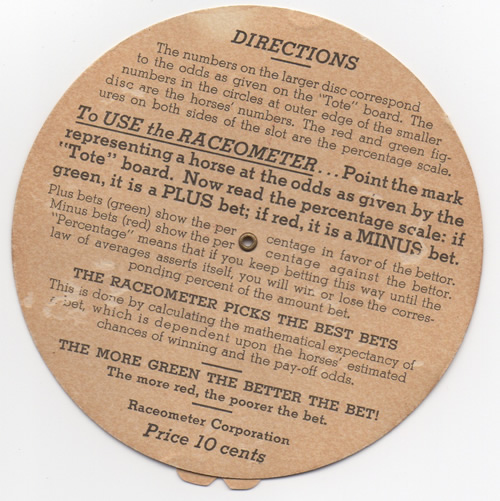Handicapping
OMG:
“They’ve turned the Kentucky Derby into a guessing game,” [Thoro-Graph proprietor Jerry Brown] fumed. “The introduction of synthetic tracks has created mass confusion among handicappers. In the Derby, you’re left to guess whether a horse can handle dirt after running on synthetics.
“This is an absurd situation to create for people who bet the game seriously. It’s tough enough to beat it with good information and rational thinking, but now you have situations where it turns a race into pure guesswork.”
Actually, the synthetic-to-dirt surface switch seems to be one of the more predictable elements in handicapping the Kentucky Derby in recent years.
1:30 PM Addendum: Dean smartly notes on Pull the Pocket that when it comes to assessing surface changes, handicapping principles still apply, but “the questions you have to analyze just might be a little different.”
Bill Christine’s search for a Kelco put me in mind of my favorite piece of handicapping ephemera, a volvelle for assessing value called the Raceometer:

“The more green the better the bet!” Handy, but at 10 cents a race, pricey.

I’ve been on the lookout for more Raceometers, but all I’ve found so far is a similarly named wheel chart, the Race-o’Meter (note the odd apostrophe), produced by the Southern California Research Company in 1948:

Unlike the Raceometer, a tool for betting, the Race-o’Meter considers eight factors to create individual horse ratings. “Be sure you have a racing form before you when use you the Race-o’Meter,” advises the instructions:

It’s science! Beginning in the 1930s and continuing into the 1970s, “scientific” and “scientifically” were favored adjectives of marketers hawking handicapping systems and methods. In 1933, as defined in “Systology: The Science of Wagering Upon Horse Races,” a compendium of eight chart-heavy betting systems, “scientific” meant the complete eradication of individual judgment. “By the use of ‘Systology,’ the human equation is removed from wagering,” wrote the authors. “It leaves nothing to the imagination.” (How dull.) In 1961, “Science in Betting” assured its readers that it would tout no “miraculous betting-system,” instead, it would teach bettors how to use “scientifically collected” data, “which if applied intelligently can work consistently and accurately.” Just like the Race-o’Meter claimed, and most likely, the Kelco.
As racing secretaries scramble to fill cards, under pressure from year-round racing and declining horse populations, deciphering complex race conditions is becoming more difficult for handicappers, writes Bob Fortus:
Little by little, claiming races with restrictions started creeping into the programs. The ‘B’ races, which started on the East Coast several years ago, are the latest form of restricted claiming. In those races, it can be particularly difficult to single out horses as serious contenders.
Optional claiming/allowance races are common everywhere, too. Handicappers suddenly are confronted with questions they rarely would have encountered just a few years ago, such as, Can a sharp and capable 3-year-old with only two victories in his career beat a tough, old claiming horse with several career victories.
Steve Davidowitz wrote about how to spot live horses among “gobbledygook” conditions in a 2009 DRF+ column (via HRF). For more in-depth treatment, nothing beats James Quinn’s “The Handicapper’s Condition Book.”
Copyright © 2000-2023 by Jessica Chapel. All rights reserved.